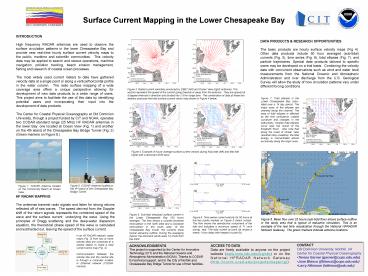Surface Current Mapping in the Lower Chesapeake Bay - PowerPoint PPT Presentation
1 / 1
Title:
Surface Current Mapping in the Lower Chesapeake Bay
Description:
During the averaging period, the dominant winds were 10 knots from the SSW. ... The vectors represent the speed of the current going towards or away from the antenna. ... – PowerPoint PPT presentation
Number of Views:36
Avg rating:3.0/5.0
Title: Surface Current Mapping in the Lower Chesapeake Bay
1
Surface Current Mapping in the Lower Chesapeake
Bay
INTRODUCTION High frequency RADAR antennas are
used to observe the surface circulation patterns
in the lower Chesapeake Bay and provide near
real-time hourly surface current velocity maps to
the public, maritime and scientific communities.
This velocity data may be applied to search and
rescue operations, maritime navigation, pollution
tracking, beach erosion management, fishing and
research of coastal ocean processes. The most
widely used current meters to date have gathered
velocity data at a single point or along a
vertical/horizontal profile in the water column.
The radio surface mapping of a wide coverage area
offers a unique perspective allowing for
development of new data products to a wider range
of users. This project aims to facilitate the
use of this data by identifying potential users
and incorporating their input into the
development of data products. The Center for
Coastal Physical Oceanography at Old Dominion
University, through a project funded by CIT and
NOAA, operates two CODAR standard range (25 MHz)
HF RADAR antennas in the lower Bay one located
at Ocean View (Fig. 1) and another on the 4th
island of the Chesapeake Bay Bridge Tunnel (Fig.
2) (Green markers on Figure 8.)
DATA PRODUCTS RESEARCH OPPORTUNITIES The basic
products are hourly surface velocity maps (Fig
4). Other data products include 50 hour averaged
(sub-tidal) currents (Fig. 5), time series (Fig.
6), tidal ellipses (Fig. 7), and particle
trajectories. Special data products tailored to
specific users may be developed on a trial basis.
Combining the velocity data with concurrent
observations such as wind and water level
measurements from the National Oceanic and
Atmospheric Administration and river discharge
from the U.S. Geological Survey will allow the
study of how circulation patterns vary under
different forcing conditions.
Figure 3. Radial current velocities produced by
CBBT (left) and Ocean View (right) antennas. The
vectors represent the speed of the current going
towards or away from the antenna. They are
spaced at 5 degree intervals in direction and
divided into 1.5 km range bins. The combination
of data at these two stations produces the total
surface current vector map shown in Figure 4
below.
Figure 7. Tidal ellipses in the Lower Chesapeake
Bay calcu-lated over a 14 day period. The major
axes of the ellipses are oriented along the
channel. The area of tidal ellipses is affected
by the river confluence, coastal curvature and
changes in the bathymetry. Smaller tidal ellipses
occur near the mouth of the Elizabeth River.
Also note that along the coast of Ocean View
(southern Bay coastline), the tidal energy is
concentrated almost exclusively along the major
axes.
Figure 4. Example of hourly average surface
current vectors during flood tide (left) and ebb
tide (right) with a dominant SSW wind.
HF RADAR MAPPING The antennas transmit radio
signals and listen for strong returns reflected
off of sea waves. The speed derived from the
Doppler shift of the return signals represents
the combined speed of the wave and the surface
current underlying the wave. Using the
principles of Bragg scattering and the deep-water
dispersion equation, the theoretical phase speed
of the wave is calculated and subtracted out,
leaving the speed of the surface current.
Figure 5. Sub-tidal (residual) surface current in
the Lower Chesapeake Bay (50 hours average). The
flow shows a counter-clockwise recirculation in
the north area and a clockwise recirculation in
the south area. At the Chesapeake Bay mouth, the
currents show typical estuarine outflow. During
the averaging period, the dominant winds were 10
knots from the SSW.
Figure 6. Time series current velocity for 50
hours at the two points marked on Figure 5 (black
circles). The flow shows the semidiurnal
component of the tide and indicates a maximum
speed of 71 cm/s during ebb. The tidal current
at point (a) shows a nearly 1 hour delay with
respect to point (b).
Figure 8. Mean flow over 25 hours (sub-tidal
flow) shows surface outflow in the study area
that is typical of estuarine circulation. This is
an example of the real time visualization through
the National HFRADAR Network Gateway. The green
markers indicate antenna locations.
In an HF RADAR network, radial maps (Fig. 3) from
two or more remote sites are combined at a
central station to make a total current vector
map (Fig. 4). Communication between the remote
site and the central site is through a computer
modem or Ethernet network (CODAR manual).
- CONTACT
- Old Dominion University, Norfolk, VA
- Center for Coastal Physical Oceanography
- Teresa Garner (garner_at_ccpo.odu.edu)
- Jose Blanco (jlblanco_at_ccpo.odu.edu)
- Larry Atkinson (latkinso_at_odu.edu)
ACCESS TO DATA Data are freely available to
anyone on the project website (www.lions.odu.edu/o
rg/cbc) or on the National HFRADAR Network
Gateway (http//cordc.ucsd.edu/projects/mapping/).
ACKNOWLEDGMENTS This project is supported by the
Center for Innovative Technology (CIT) and the
National Oceanic and Atmospheric Administration
(NOAA). Thanks to CODAR for technical support,
and to the City of Norfolk and Chesapeake Bay
Bridge Tunnel for use of their facilities.































